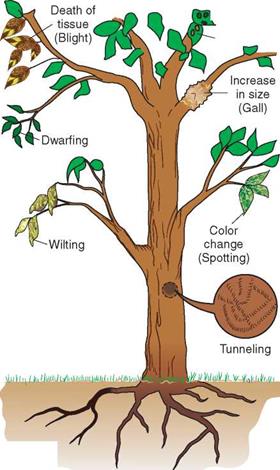Resulting from the destruction of chlorophyll, color changes may be localized (spots, rings, lesions) or widespread through the plant. Lack of light turns a plant yellow in a condition termed etiolation.
When the plant turns yellow but does not lack light, the symptom is termed chlorosis. Chlorosis is probably the most common of all color changes. It can be caused by insects, pathogens, or environmental problems.
|
|
|

figure 6-13. Symptoms of plant injury (Delmar/ Cengage Learning)
Rotting
Rotting results from a destruction of the host cells that causes a release of the cellular fluids. It may be accompanied by a strong, often foul, odor. Rots may be dry or soft and occur in the roots, leaves, stems, buds, or fruits. They are usually the result of plant diseases or freezing.
Death of Tissue
When tissue becomes desiccated (dried out) and dies, it usually turns brown or black, and is said to be necrotic. The dead tissue, or necrosis, may be localized on leaves as spots or centered in young buds. It may also be extensive, encompassing entire branches as in blights. Insects, pathogens, or environmental factors can cause necrosis. It ranks with chlorosis in the frequency of its presence. It is often the final symptom in the symptom complex.
Dwarfing
All or part of a plant can be reduced in size as a result of pathogens (especially viruses and viroids), insects, and nematodes. Dwarfing may result from the reduction of water uptake at a time when new tissue is expanding. Insects or nematodes in the root system of a plant may create
such dwarfing, which results from a reduction in cell size (hypotrophy) or number (hypoplasia). Hypotrophic or hypoplastic reactions by the plant can result in local or overall dwarfing. Both conditions can occur simultaneously.
Increase in Size
Plant parts may become malformed in response to insect or pathogenic irritants. As cells increase in size (hypertrophy) or in number (hyperplasia), symptoms are expressed as galls, witches brooms, swollen roots, abnormal shoot growth, scabs, and fasciations.
Tunneling
Insects may bore into plant trunks, chew their way between the upper and lower epidermis of leaves, and tunnel up and down the stems. Borers and leaf miners commonly create such injury in plants.
Holes
Leaves filled with holes are symptomatic of both insect and pathogenic causes. Insects usually cause holes by feeding on the leaf tissue. When caused by pathogen activity, the holes are preceded by necrotic lesions and spots that represent dead cells. As the tissue dies in these localized areas, the necrotic areas drop out, creating the holes.
Hundreds of combinations and variations of symptoms can result from the many possible causal agents, reactions of individual host plants, and unpredictable modifications caused by the environment. If the quick and accurate diagnosis of what is troubling a particular host plant sounds difficult, be assured it is!



